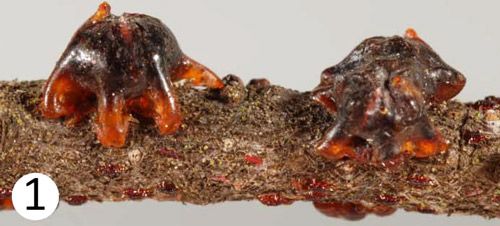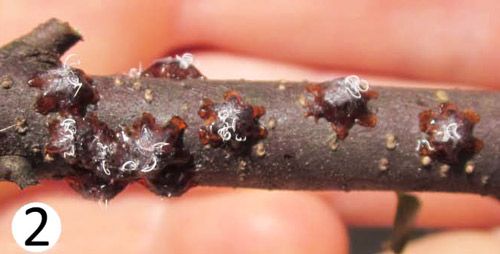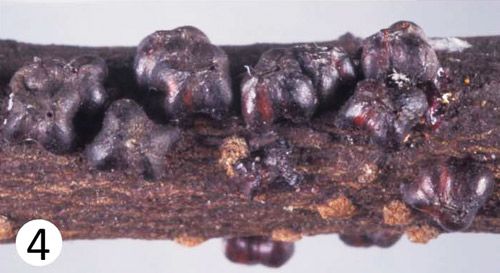The Featured Creatures collection provides in-depth profiles of insects, nematodes, arachnids and other organisms relevant to Florida. These profiles are intended for the use of interested laypersons with some knowledge of biology as well as academic audiences.
Introduction
The Mexican lac scale, Tachardiella mexicana (Comstock) (Hemiptera: Kerriidae), is native to Mexico and Texas. This species was first discovered in Florida in 1985 at a theme park in Lake Buena Vista, and a second population was discovered in 1987 at a nursery in Seminole County that is no longer in business. In 2006, a population was discovered in Fort Myers (Lee County), and a re-sampling of the area in 2010 revealed that the populations were established on the host trees. Before June 2010, all host records, including both previously published host records and unpublished host records maintained by the Division of Plant Industry (DPI), were from fabaceous plants such as Acacia spp., Pitheleocelobium flexicaule, Ebenopsis ebano, and Lysiloma spp. However, in June 2010, a second population at Lake Buena Vista was discovered feeding on wax myrtle, Myrica cerifera (Myricaceae).
Distribution
This scale is found from central to southern Texas, Arizona, Florida (Lee County, Orange County, and Seminole County), as well as in Mexico, bordering Texas.
Description
Adult female scales produce a high-domed test or shell with four to six lobe-like projections that anchor the test to the plant surface (Figures 1 and 2). The test is hard and glossy with a reddish-orange tint around the edges, and darker toward the center. In some specimens white, string-like wax fiber extrusions project from the dorsum of the test, but these may break off. In heavy infestations, the tests of multiple females will develop into a single, aggregated mass such that the distinctive appearance of the individual tests is lost (Figure 3). The test darkens as the scale matures. The female scale, which is a deep red color, lives inside the test and requires a special procedure to remove without damage. Proper identification requires that specimens be slide-mounted.

Credit: Lyle J. Buss, UF/IFAS Entomology and Nematology Department

Credit: Susan Halbert, Florida Department of Agriculture and Consumer Services, Division of Plant Industry

Credit: Lyle J. Buss, UF/IFAS Entomology and Nematology Department
The UF/IFAS Extension Lee County, published an online factsheet with illustrations on the Mexican lac scale population in Lee County that is infesting wild tamarind (Lysiloma latisiliqua) (Brown 2011). This is the second of two lac scales known in Florida. In 1999, the lobate lac scale, Paratachardina pseudolobata, was discovered in Broward County, and is now widely distributed throughout southern Florida on many hosts. Lobate lac scale is easily distinguished from the Mexican lac scale by the former's distinctive lobed, or bow tie-shaped, test (Figure 4).

Credit: Lyle J. Buss, UF/IFAS Entomology and Nematology Department
Biology
Hosts include Acacia cornigera, Acacia pinetorum, Ebenopsis ebano, Lysiloma sabicu, Lysiloma latisiliquum, Mimosa sp. (Fabaceae), and Myrica cerifera (Myricaceae).
Hosts
Acacia cornigera, Acacia pinetorum, Ebenopsis ebano, Lysiloma sabicu, Lysiloma latisiliquum, Mimosa sp. (Fabaceae); Myrica cerifera (Myricaceae).
Economic Importance
There are no published reports of economic losses caused by this species. Gillian Watson (personal communication, CDFA) reports that even though an untreated infestation can kill a plant, it has not had an economic effect on succulent production in California.
Natural Enemies
The online scale database ScaleNet lists no natural enemies, but several parasitoids are recorded in the Universal Chalcidoidea Database (Noyes 2012) for the related species Tachardiella larreae (Comstock), also native to the southwestern United States (Texas, Arizona) and Mexico.
Aphelinidae: Marietta albocephala Hayat
Encyrtidae: Tachardobius nigricans Timberlake, Tachardobius vladimiri Triapitsyn.
None of the parasitoids are currently known from Florida.
Selected References
Chamberlin JC. 1923. A systematic monograph of the Tachardiinae or Lac Insects (Coccidae). Bulletin of Entomological Research 14: 147–212.
Ferris G. 1955. Atlas of the scale insects of North America, v. 7, the families Aclerdidae, Asterolecaniidae, Conchaspididae, Dactylopiidae and Lacciferidae. iii. Stanford University Press, Palo Alto, California. 233 p.
Howard FW, Pemberton R, Hamon A, Hodges GS, Steinberg B, Mannion CM, McLean D, Wofford J. 2004. Lobate lac scale, Paratachardina lobata lobata (Chamberlin) (Hemiptera: Sternorrhyncha: Coccoidea: Kerriidae). Gainesville: University of Florida Institute of Food and Agricultural Sciences. (February 2019)
Kondo T, Gullan PJ. 2011. Taxonomic review of the genus Tachardiella Cockerell (Hemiptera: Kerriidae), with a key to species of lac insects recorded from the New World. Neotropical Entomology 40: 345–367.
Noyes JS. 2012. Universal Chalcidoidea Database. World Wide Web electronic publication. (February 2019)
Triapitsyn S. 2008. A review of Tachardobius (Hymenoptera: Encyrtidae), with description of a new species from California, USA, a parasitoid of Tachardiella spp. (Hemiptera: Kerriidae). Zootaxa 1716: 44–52.